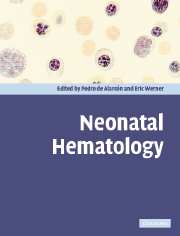Book contents
- Frontmatter
- Contents
- List of contributors
- Foreword
- Preface
- 1 Neonatal hematology: a historical overview
- 2 Disorders of the fetomaternal unit
- 3 Erythropoiesis, red cells, and the approach to anemia
- 4 Anemia of prematurity and indications for erythropoietin therapy
- 5 Hypoplastic anemia
- 6 Hemolytic disease of the fetus and newborn
- 7 Neonatal hemolysis
- 8 Neonatal screening for hemoglobinopathies
- 9 Polycythemia and hyperviscosity in the newborn
- 10 Newborn platelet disorders
- 11 Neutrophil function and disorders of neutrophils in the newborn
- 12 Immunodeficiency diseases of the neonate
- 13 Hemostatic abnormalities
- 14 Transfusion practices
- 15 Umbilical-cord stem-cell transplantation
- 16 Neonatal oncology
- 17 Normal values and laboratory methods
- Index
- References
17 - Normal values and laboratory methods
Published online by Cambridge University Press: 10 August 2009
- Frontmatter
- Contents
- List of contributors
- Foreword
- Preface
- 1 Neonatal hematology: a historical overview
- 2 Disorders of the fetomaternal unit
- 3 Erythropoiesis, red cells, and the approach to anemia
- 4 Anemia of prematurity and indications for erythropoietin therapy
- 5 Hypoplastic anemia
- 6 Hemolytic disease of the fetus and newborn
- 7 Neonatal hemolysis
- 8 Neonatal screening for hemoglobinopathies
- 9 Polycythemia and hyperviscosity in the newborn
- 10 Newborn platelet disorders
- 11 Neutrophil function and disorders of neutrophils in the newborn
- 12 Immunodeficiency diseases of the neonate
- 13 Hemostatic abnormalities
- 14 Transfusion practices
- 15 Umbilical-cord stem-cell transplantation
- 16 Neonatal oncology
- 17 Normal values and laboratory methods
- Index
- References
Summary
Introduction
Profound changes in the normal values for blood components occur during gestation and the first few months of life. The developmental aspects of hematopoiesis must be considered in the evaluation of the neonatal blood picture. Additionally, the timing and site of blood sampling can affect the results. Because of a broad normal range for many factors, the clinician should be aware that the presence of an abnormal condition is not always excluded by a normal laboratory test.
Red blood cell measurements
Complete blood counts (CBC) are performed routinely on automated cell counters, which function by one of two principles: voltage pulse-impedance or light scatter. For the interested reader, the operation of these instruments has been described [1]. The red blood cell count (RBC) and mean cell volume (MCV) are measured directly by these instruments, while the hematocrit is calculated from these values. Alternatively, the hematocrit also can be measured by direct centrifugation of blood in a microhematocrit tube filled by capillary action. Hemoglobin (Hb) is measured directly by automated cell counters [1]. The mean cell hemoglobin (MCH) and mean cell hemoglobin concentration (MCHC) are calculated values. Most automated cell counters also create histograms of red-blood-cell size and determine the red-cell distribution of width (RDW), a quantitative measure of the variation in red-cell size.
Normal values for Hb, hematocrit (Hct), RBC, and indices for fetuses and infants on the first day of life are shown in Table 17.1 [2–4].
- Type
- Chapter
- Information
- Neonatal Hematology , pp. 406 - 430Publisher: Cambridge University PressPrint publication year: 2005
References
- 7
- Cited by

